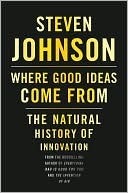More on this book
Community
Kindle Notes & Highlights
the number of heartbeats per lifetime tends to be stable from species to species.
life gets bigger, it slows down.
as cities get bigger, they generate ideas at a faster clip.
acceleration; the new paradigms keep rolling in, and the intervals between them keep shortening.
the 10/10 rule: a decade to build the new platform, and a decade for it to find a mass audience.
Our thought shapes the spaces we inhabit,
openness and connectivity may, in the end, be more valuable to innovation than purely competitive mechanisms.
we can build environments that do a better job of nurturing good ideas,
much value to be found in seeking the common properties across all these varied forms of innovation and creativity
we are often better served by connecting ideas than we are by protecting them.
Good ideas may not want to be free, but they do want to connect, fuse, recombine. They want to reinvent themselves by crossing conceptual borders. They want to complete each other as much as they want to compete.
adjacent possible.” The phrase captures both the limits and the creative potential of change and innovation.
The adjacent possible is a kind of shadow future, hovering on the edges of the present state of things, a map of all the ways in which the present can reinvent itself.
The strange and beautiful truth about the adjacent possible is that its boundaries grow as you explore those boundaries. Each new combination ushers new combinations into the adjacent possible.
the path of evolution is as a continual exploration of the adjacent possible.
gradual but relentless probing of the adjacent possible, each new innovation opening up new paths to explore.
Good ideas are not conjured out of thin air; they are built out of a collection of existing parts,
we are surrounded by potential new configurations, new ways of breaking out of our standard routines.
encourage novel ways of recombining
The trick to having good ideas is not to sit around in glorious isolation and try to think big thoughts. The trick is to get more parts on the table.
A good idea is a network.
A new idea is a network of cells exploring the
adjacent possible of connections that they can make in your mind.
When a new idea pops into your head, the sense of novelty that makes the experience so magical has a direct correlate in the cells of your brain: a brand-new assemblage of neurons has come together to make the thought possible.
The connections are the key to wisdom,
to make your mind more innovative, you have to place it inside environments that share that same network signature: networks of ideas or people that mimic the neural networks of a mind exploring the boundaries of the adjacent possible.
First, a capacity to make new connections with as many other elements as possible. And, second, a “randomizing” environment that encourages collisions between all the elements in the system.
innovative systems have a tendency to gravitate toward the “edge of chaos”: the fertile zone between too much order and too much anarchy.
liquid network creates a more promising environment for the system to explore the adjacent possible.
Good ideas could more readily find their way into other brains and take root there. New forms of collaboration became possible.
The idea was too powerful not to spill over into other nearby minds.
distributes decision-making authority across a much larger network of individual minds.
the individuals get smarter because they’re connected to the network.
“the results of one person’s reasoning became the input to another person’s reasoning . . . resulting in significant changes in all aspects of the way the research was conducted.”
the most productive tool for generating good ideas remains a circle of humans at a table, talking shop.
increased fluidity—all those new ideas jostling against each other, in rooms expanding and contracting to meet their needs—it’s
This is how slow hunches often mature: by stealth, in small steps. They fade into view.
commonplace book.
Reading and writing were therefore inseparable activities. They belonged to a continuous effort to make sense of things,
the bibliographic history of epic miscellany,
process of accretion, not the linear solving of one problem after another.
dreams are the mind’s primordial soup: the medium that facilitates the serendipitous collisions of creative insight.
in challenging times, an organism needs new ideas to meet those new challenges.
completes a hunch, or opens up a door in the adjacent possible that you had overlooked.
widening the network of minds who were actively thinking about how to make its ideas more useful,
The secret to organizational inspiration is to build information networks that allow hunches to persist and disperse and recombine.
Being right keeps you in place. Being wrong forces you to explore.
Transforming error into insight
good ideas are more likely to emerge in environments that contain a certain amount of noise and error.
complicated relationship between accuracy and error, between signal and noise,


